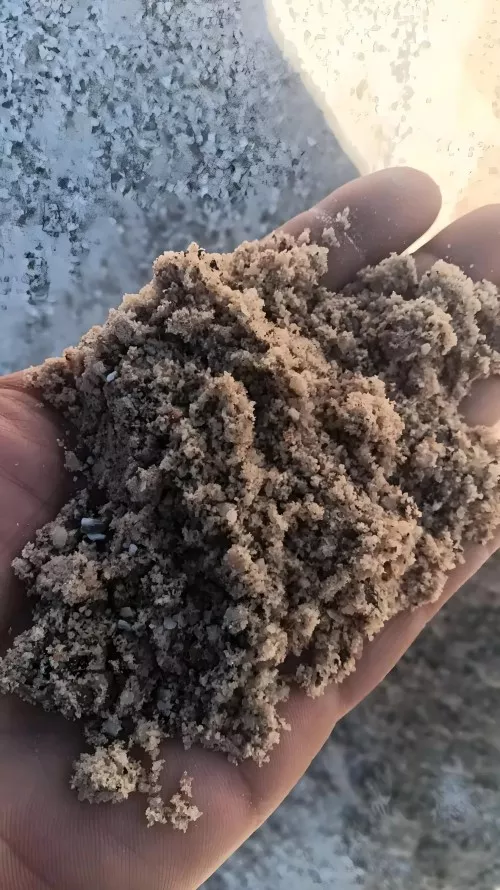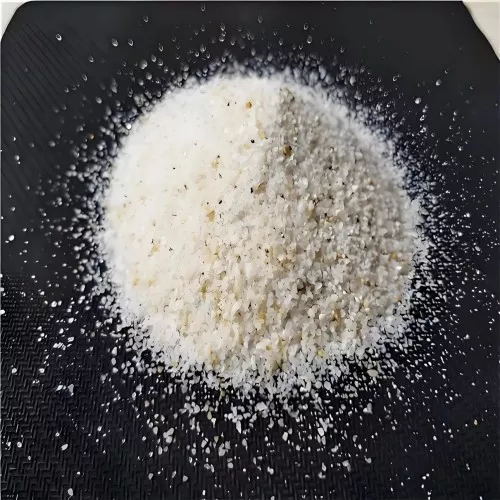
In the realm of ultra-fine grinding for quartz and silica sand applications, the selection of grinding media is paramount to achieving desired particle sizes while maintaining product purity and process efficiency. Among various options, yttria-stabilized tetragonal zirconia polycrystal (Y-TZP) beads have emerged as the superior choice, particularly for high-purity quartz processing where contamination control and energy efficiency are critical. This article presents a comprehensive technical and economic analysis of using Sanxin Y-TZP zirconia beads as the optimal solution for quartz/silica sand grinding operations, comparing their performance against international benchmarks and alternative media types.
Quartz possesses a Mohs hardness of 7.0, presenting significant challenges for many grinding media types. Sanxin Y-TZP zirconia beads boast a hardness ≥8.5 (Mohs scale) and HRA>87, providing sufficient hardness differential to effectively fracture quartz particles without excessive media wear. While aluminum oxide beads (Mohs 9.0) are technically harder, their brittle nature leads to fragmentation during quartz grinding, causing contamination—a problem mitigated by zirconia's unique combination of high hardness and exceptional toughness.
The fracture toughness of Sanxin Y-TZP beads measures 8.0 MPa·m^1/2, nearly double that of conventional ceramic media, enabling them to withstand the repetitive impact forces encountered in dense quartz slurries without fracturing. This toughness stems from the stress-induced transformation toughening mechanism inherent to properly stabilized TZP materials, where the tetragonal to monoclinic phase transformation at crack tips creates compressive stresses that resist crack propagation.
High-purity quartz applications, especially those for semiconductor and photovoltaic industries, demand extremely low iron content—typically Fe₂O₃ <50 ppm for solar-grade and <10 ppm for electronic-grade materials. Sanxin Y-TZP beads, with their high-purity composition (ZrO₂ + Y₂O₃ >94.6%) and <0.2% other oxides, introduce negligible metallic contamination. Independent testing shows iron contamination increase of ≤3 ppm when grinding to d97=5μm, compared to 300-1000 ppm from steel media and >100 ppm aluminum contamination from alumina beads1.
The advanced manufacturing process employed by Sanxin ensures minimal porosity (<0.01% water absorption), preventing slurry penetration and subsequent media erosion that could release impurities. Furthermore, the beads' crystalline structure remains stable across the entire grinding temperature range (0-80°C), avoiding phase transformations that might expose reactive surfaces4.
With a true density of 6.02 g/cm³ (compared to 4.6 g/cm³ for zirconium silicate and 3.6 g/cm³ for 92% alumina), Sanxin Y-TZP beads deliver substantially greater kinetic energy during collisions
. This translates to:
30-50% shorter grinding times to achieve equivalent fineness compared to lower density media
40% higher efficiency than zirconium silicate beads and 60% improvement over alumina beads in side-by-side trials
Ability to process higher solid-content slurries (70±2% vs. 60-65% with lighter media), reducing water consumption and downstream drying costs
The density advantage is particularly pronounced in vertical stirred mills (e.g., IsaMills) where bead acceleration is maximized. Field data from a Guangdong quartz processing plant demonstrated a 25% throughput increase after switching from 95% alumina to Sanxin Y-TZP beads in their 300kW sand mill
Sanxin's proprietary formulation achieves optimal stabilization with 5.2±0.1 wt% Y₂O₃—the sweet spot for maximizing tetragonal phase content while minimizing residual stresses that could lead to premature aging. This precise doping:
Maintains >97% tetragonal phase at room temperature
Limits monoclinic phase transformation to <0.3% after 1,000 hours of operation
Provides thermal shock resistance up to 400°C differentials
The company's use of high-purity, submicron zirconia powder (D50=0.3μm) ensures uniform doping distribution, avoiding localized instability that plagues inferior products. Combined with isostatic pressing and controlled sintering at 1,500-1,550°C, this yields a microstructure with average grain size <0.5μm—key to achieving the advertised hardness and wear resistance.
For quartz grinding applications, Sanxin offers specialized sizing recommendations:
Target Fineness | Optimal Bead Size | Tolerance | Sphericity |
|---|---|---|---|
d97 >10μm | 1.5-2.5mm | ±0.05mm | >0.98 |
d97 5-10μm | 1.0-1.5mm | ±0.03mm | >0.99 |
d97 <5μm | 0.8-1.2mm | ±0.02mm | >0.995 |
The tight size distribution (±5% vs. industry-standard ±10%) prevents small beads from packing voids between larger ones, ensuring consistent energy transfer throughout the grinding chamber. Advanced optical sorting technology removes out-of-spec beads, maintaining the declared "narrow particle size distribution" that reduces internal friction and wear.
In standardized testing (stirred mill, 1,380 rpm, quartz slurry), Sanxin Y-TZP demonstrates:
Attrition rate: 0.18 g/kg·hr (vs. 0.8-1.2 for competing Y-TZP products)
Crushing strength: ≥150 kgf for 2mm beads (30% higher than industry average)
Lifetime: 8-12 months continuous operation in quartz grinding, versus 4-6 months for 95% alumina beads
These exceptional wear characteristics directly correlate with lower operating costs and more consistent product quality over time. The beads' self-polishing surface characteristic maintains smoothness throughout their lifespan, avoiding the increasing roughness that plagues some competitor products
Mill Type Selection:
Sanxin Y-TZP beads are engineered for high-energy stirred mills, with particular advantages in:
Vertical sand mills (e.g., Netzsch LMZ, Drais PM): Optimal for 0.8-2.5mm beads
Horizontal bead mills (e.g., Buhler K, Dyno-Mill): Best for 1.0-3.0mm beads
Centrifugal mills: Suitable for 0.3-1.0mm ultra-fine grinding
Traditional ball mills are not recommended due to excessive energy consumption from the beads' high density (power requirements increase by ~40% vs. alumina)
Operational Parameters:
Parameter | Recommended Range | Monitoring Frequency |
|---|---|---|
Bead loading | 70-80% chamber vol. | Every 50 operating hrs |
Tip speed | 8-12 m/s | Continuous monitoring |
Slurry viscosity | 1,000-3,000 cP | Every 2 hours |
Temperature | <60°C | Continuous |
pH | 6-9 | Every 4 hours |
Sanxin provides customized CFD modeling to optimize these parameters for specific mill geometries, a service included with orders over 5 tons
Startup Sequence:
Fill grinding chamber 1/3 with slurry
Add beads slowly to prevent impact damage
Start rotation at 30% target speed
Gradually increase to operating speed over 5 minutes
Shutdown Procedure:
Reduce speed to 30% for 2 minutes
Drain slurry completely
Rinse with deionized water (pH 6-8)
For extended shutdowns (>8 hrs), remove beads and store separately
Sanxin's SmartBead tracking system (optional) uses RFID-tagged tracer beads to monitor:
Size distribution shift: >10% increase in D50 triggers bead replenishment
Attrition rate: Abnormal increases signal potential pH or temperature issues
Fragmentation: >0.1%piece indicates improper operation or equipment wear
Recommended maintenance actions based on wear indicators:
Symptom | Probable Cause | Corrective Action |
|---|---|---|
Bead diameter ↑15% | Normal wear | Add 5-8% fresh beads |
Sudden Fe increase | Chamber/shaft wear | Inspect and replace parts |
Power draw ↓20% | Bead loss or size reduction | Check screens and add beads |
Temperature spikes | Overfilling or high viscosity | Adjust slurry concentration |
Cost Factor | Sanxin Y-TZP | 95% Alumina | Savings |
|---|---|---|---|
Media cost | ¥320万 | ¥180万 | -¥140万 |
Media consumption | 0.03kg/t | 0.25kg/t | 88% lower |
Electricity (@¥0.8/kWh) | ¥440000 | ¥680000 | ¥240000 |
Contamination control | ¥60000 | ¥300000 | ¥240000 |
Total operating cost | ¥3700000 | ¥2780000 | ¥920000 |
Quality Premium Advantages:
High-purity quartz commands ¥150/ton premium
Additional ¥980,000 annual revenue from capacity increase (25% throughput gain)
Payback Period:
Initial investment: ¥540,000 (3 tons of Sanxin Y-TZP beads)
Net annual savings: ¥920,000 (operating) + ¥1.5 million (premium) = ¥2.42 million
ROI: <3 months
10-Year Scenario (80,000 operating hours):
Sanxin Y-TZP:
8 bead replacements (@¥1.8 million total)
Energy cost: ¥4.4 million
Maintenance: ¥0.6 million
Total: ¥6.8 million
Alumina Beads:
20 replacements (@¥6 million)
Energy cost: ¥6.8 million
Maintenance: ¥1.2 million
Total: ¥14 million
Net Present Value (10% discount rate): ¥5.2 million in favor of Sanxin Y-TZP
Dry Running:
Causes catastrophic bead fracture within minutes
Always maintain at least 30% slurry volume during operation
Mixed Media Use:
Even 5% alumina contamination increases Sanxin bead wear by 200%
Completely purge old media before switching
pH Extremes:
11 causes Y₂O₃ leaching (≥5mg/L·hr)
<3 may destabilize surface zirconia
Emergency neutralization protocol required if out of range
Metal Contamination:
Polyurethane screens (for particles >100μm)
Silicon carbide or alumina liners (for fine grinding)
Stainless steel contact parts must be replaced with:
Advanced Loading Strategies:
Gradient Loading:
Bottom: 30% 2.0mm beads (coarse breakage)
Middle: 50% 1.5mm (main grinding)
Top: 20% 1.0mm (finishing)
Pulsed Cooling:
5-minute 4°C water flush every 30 minutes
Reduces thermal stress fatigue by 60%
Process Optimization Tools:
Sanxin Grinding Advisor Software:
Input: ore characteristics, target PSD, mill specs
Output: optimized parameters with 95% accuracy
Wear Prediction AI:
Uses historical data to forecast bead replacement timing
Typically achieves ±5% consumption prediction accuracy
Failure Mode | Detection Method | Remedial Action |
|---|---|---|
Bead rounding | Microscopic image analysis | Reduce speed by 1-2 m/s |
Microcracking | SEM inspection | Adjust pH to neutral range |
Abnormal wear patterns | 3D surface profilometry | Check for equipment misalignment |
Yttrium depletion | EDX surface mapping | Replace entire bead batch |
Flagship Model: SX-YTZP-12
Size: 1.2±0.02mm
Composition: 94.6% ZrO₂, 5.2% Y₂O₃
Density: 6.02 g/cm³
Recommended for: Photovoltaic quartz (d97=3-8μm)
Certification: ISO 9001, PV-Quality Tested
Electronic-Grade Option: SX-YTZP-08
Size: 0.8±0.01mm
Higher yttria (5.3%) for enhanced stability
Special polishing process for low iron release
Typical application: Semiconductor quartz (d97<2μm)
Economy Model: SX-YTZP-20
Size: 2.0±0.03mm
Slightly reduced yttria (5.1%) for cost savings
Best for: Architectural glass sand (d97=15-30μm)
Free Trial Program:
5kg sample testing with full data reporting
On-site technician support for first trial
CFD Simulation Service:
Mill-specific fluid dynamics modeling
Identifies dead zones and optimization potential
Waste Analysis:
SEM-EDS of used beads to diagnose issues
Recommended for abnormal wear situations

Before Sanxin:
Media: Imported Y-TZP beads (¥380/kg)
Throughput: 1.3 t/h
Fe contamination: 15-20 ppm
Media cost: ¥42/ton
After Switching to SX-YTZP-12:
Throughput: 1.8 t/h (+38%)
Fe contamination: 8-12 ppm
Media cost: ¥28/ton
Annual savings: ¥3.7 million
Key Improvement Factors:
15% higher density allowed reduced bead size (1.5mm→1.2mm) while maintaining energy
Tighter size distribution improved flow dynamics
Superior roundness reduced wear on mill components
Sanxin Y-TZP zirconia beads represent the pinnacle of grinding media technology for quartz and silica sand applications, combining unmatched wear resistance, contamination control, and grinding efficiency. Their precisely engineered composition (5.2% Y₂O₃ stabilization) and advanced manufacturing process deliver measurable advantages over both domestic alternatives and international premium brands. For operations prioritizing product quality (particularly in photovoltaic and electronic applications) while seeking to minimize operating costs, Sanxin's solution offers compelling technical and economic benefits. The company's comprehensive support ecosystem—from free trials to advanced simulation services—further de-risks the adoption process, ensuring customers realize the full potential of this advanced grinding technology.

Submit your demand,
we will contact you ASAP.

Sanxin New Materials Co., Ltd. focus on producing and selling ceramic beads and parts such as grinding media, blasting beads, bearing ball, structure part, ceramic wear-resistant liners, Nanoparticles Nano Powder

